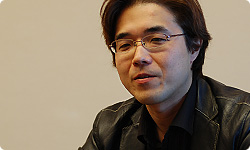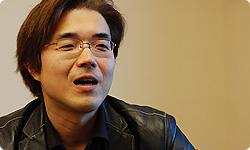4. Just Like on a Home Console
So Koinuma-san, the subtitle this time is Chronicles. Why is that?
The first thing we decided this time was to unravel the thread of history of the Sengoku period. An awful lot happened from the beginning of the Sengoku period to the beginning of the Edo period, so we decided to follow that long history. The game is made so that if you clear it, you can study the overall history of the Sengoku period and what happened on which battlefields.
About when do you place the beginning of the Sengoku period?
It begins with the Kawagoe Night Battle in 1546. At that time, Ujiyasu Hojo, Yoshimoto Imagawa and Shingen Takeda had formed a triple alliance. From that time on, the Toyotomi clan declines, culminating in the summer campaign of the siege of Osaka in 1615.
That’s a lot.
Yes. The game has quite a lot of volume. We decided to trace that long history, so this time we decided to have a single fictional player-character who experiences battlefields at various time periods.
Is this the first time that such a character has appeared in the Warriors series?
Yes. This is the first time we’ve made a fictional character the main character.
The real thrill of the series so far has been the exhilaration of playing as your favourite warlord. Did a debate break out over players playing an alternate self?
The main characters are the warlords, of which there are over 40 this time. Not everyone will like all 40, so the player-character doesn’t address others, but can be talked to, with the warlords asking him or her questions and so on.

Oh, I see. The player-character stands in for the player.
Yes. So we didn’t give the player-characters distinctive characteristics, but kept them rather featureless.
It’s easier for players to put themselves into the player-character if they aren’t distinguished too much.
Right. But we do give the players certain goals, and the choices they make along the way affect the course of the story. I thought it would be fun if players could deal with the warlords and interact with them.
The great warlords are directly addressing you as the character.
Right. I hope players feel like they are talking directly with the warlords. And this time there are over 30 scenarios, the most ever for a Warriors game played as a single character. And until now, when you switched to another character, you had to develop them from their base stats, but this time the player-character continually advances, so you can enjoy the scenario much longer than ever before.
By portraying the longer Sengoku period, more warlords appear, and there are more events, so it’s bigger than ever before.
Yes. We did a little too much, and to be honest, I began to worry over whether development would ever end! (laughs)
Until now, it’s been common sense that handheld games that uses semiconductor memory (ROMs) as the game storage medium don’t hold as much content as games on home consoles.
But this time, Nintendo said we can use even a two-gigabyte ROM. They said that with so much memory capacity we could make something comparable to a home console game, so we didn’t hold back!
Did you use those two gigabytes to your heart’s content? (laughs)
Yeah. We might have gone overboard. (laughs)
You could say that you were able to do as much as you did because you had the large capacity of a two-gigabyte ROM.
That’s right.
But it was pretty hard preparing a two-gigabyte ROM in time for release of the Nintendo 3DS system. But the Licensing department that works with outside companies strongly requested it hearing feedback from those companies. Some at Nintendo were saying, ”Do you even need all this storage space?” and “How are you going to fill it all with data?”
Nah, it was easy! Oh, well, maybe I shouldn’t say that... (laughs) Actually, there are a lot of voices and cut scenes in this game.
That’s right, it’s full voice this time.
Yes. When Warriors games came out for another handheld, we had to cut back on voice to save space, but there was no need for that this time, so it’s the first time we could include voice on almost all of the game.
That’s the advantage of making software with a semiconductor memory. Unlike with optical disks, you can ignore seek time21, so you can call forth the voice immediately wherever the data for it is on the ROM. 21 Seek Time: The time it takes for the read/write device to read data from a specific data location on recorded media such as optical discs. With semiconductor media (ROMs), data can be read off from anywhere within the recorded media without any significant difference in seek timing. With optical disc media on the other hand, the seek time may vary depending on the physical location of the data on the disc.
Right. So this time, as with home consoles, we could make it so all sorts of characters are talking all the time, even during battle.
Does it make you happy that they can talk?
Yeah. (laughs) We re-recorded all the voices this time. If we reused previous recordings, there are lots of fans who like the voice actors, and they would notice right away.

Fans of the voice actors would point out how the sound was the same as last time?
Yes. As the series builds up, an increasing number of different tastes emerge, with some players simply liking the action, others the history, others particular characters, and so on.
While Samurai Warriors is a single series, it possesses various entry points for the players’ varying tastes.
Yes. Since some fans like the voice actors and we had so much memory capacity this time, I thought they would like it if we went full voice, but partway through development, I thought, “Uh-oh, I’m doing too much.” (laughs)
(laughs) And there isn’t anyone there to step on the brakes to stop you.
Yeah! (laughs) But when I tried to put in all sorts of stuff toward the end of development, everyone said, “That’s the limit!”
(laughs)
Of course, they stopped me when something just wouldn’t fit, and at the end I applied the brakes myself! (laughs)